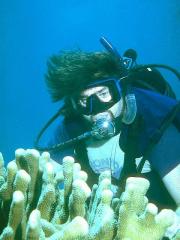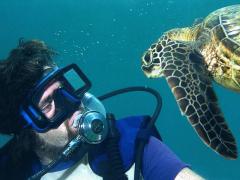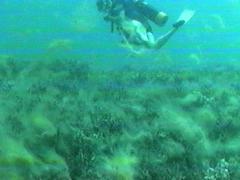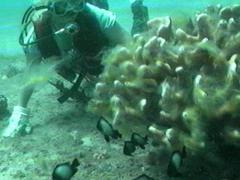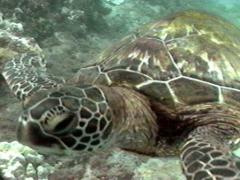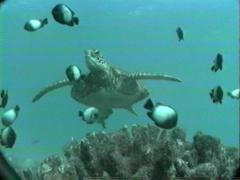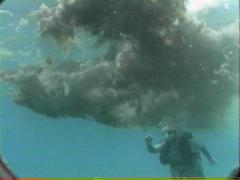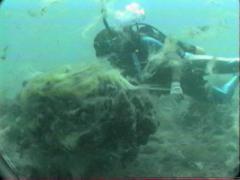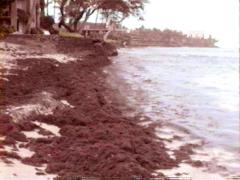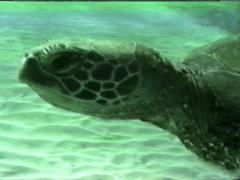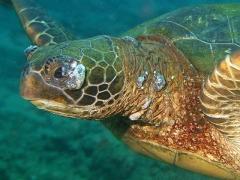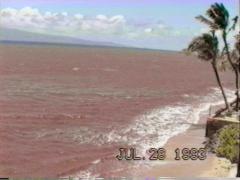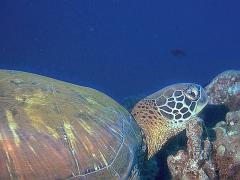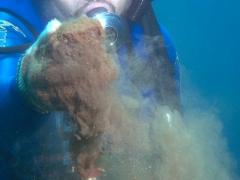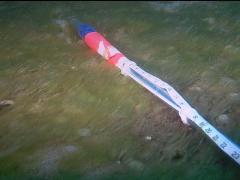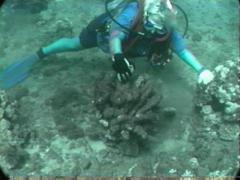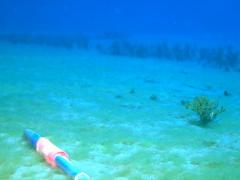An Underwater History of Honokowai (1988-1995)
Algae Blooms, Coral Heads, and Sea Turtles
|
This essay is dedicated to these four juveniles, who all developed tumors within two to five years of our first sighting. From left to right:
- Clothahump: first seen 1988, developed tumors by 1993, not seen since 1993.
- Noke: first seen 1992, developed tumors by 1994, not seen since 1994.
- Howzit: first seen 1992, developed tumors by 1995, not seen since 1995.
- Four Spot: first seen 1992, developed tumors by 1995, not seen since 1995.
Peter Bennett (honu@turtles.org)
Ursula Keuper-Bennett (howzit@turtles.org)
|
1988
At Honokowai in 1988, corals were healthy and abundant. Back then, Honokowai was rated among the top Maui snorkeling spots. To see why, you just needed to snorkel out to the 4-5 metre (13-17 foot) depth. That's where the coral gardens began.
Near the shore along Honokowai, from Honokowai Park up to S-Bend, the water is shallow for quite some distance out. In most places, you don't reach a depth of 10 metres (33 feet) until you are 75-100 metres from the beach. (That's roughly 80-110 yards.) At the 5 metre (17 foot) depth, there was once a garden of low coral growth extending all along that coastline. Today, large parts of those coral gardens are dead.
Algae blooms and runoff from concrete erosion control channels without catch basins have taken their toll. To illustrate Honokowai's aquatic history, this essay tells the story of two individual residents of this reef from 1988 to the summer of 1995.
The first is a large example of Pocillopora eydouxi, often called elkhorn locally. This coral head stood out so well that we used it as an underwater landmark. Not only was it beautiful, it played host to a school of two dozen or more Hawaiian damselfish (Dascyllus albisella). Here it is in 1988, handsome and healthy.
|
|
A large example of Pocillopora eydouxi, often called "elkhorn" locally.
64K JPEG
|
The second resident is a young Hawaiian green sea turtle. Individuals of this species are easy to identify by their left and right profiles. The patterns of markings on their faces are fixed and as unique to the individual as fingerprints are to us.
This is Clothahump when we first met her in 1988. She was a small turtle, too small for us to know for sure what her sex really was, but we always thought of her as female. Judging by her size and her beautiful, algae-free shell, she was probably in her first year inshore. She was certainly healthy, engaging, and curious about us. Clothahump introduced herself by swimming right up to us while we were photographing eels. After our first encounter, we saw her almost daily for the rest of the summer.
1989
In the summer of 1989, West Maui was plagued by a massive algae bloom in its nearshore waters. As far as we could determine, this was the first bloom of its kind. The major nuisance was a green macroalgae, Cladophora sericea.
|
|
Large tracts of the Honokowai reefs were blanketed in Cladophora.
39K JPEG
|
At Honokowai, the reefs run perpendicular to the shoreline and also to the prevailing current. Large tracts of these reefs were blanketed in Cladophora, as seen in this image. The Cladophora that didn't snag on the corals tended to collect in large pads in the depressions and valleys between the reefs.
When strong currents were running, Cladophora floated throughout the water column and would snag on many corals throughout our dive site. From the accompanying video image, you can see that our landmark coral head was still alive in 1989, but was covered with wisps of algae. While this coral still looked healthy that year, the fact that it snagged algae so easily worried us. We were aware that coral polyps can be overwhelmed and smothered by algae growth. We could see that it was in great trouble.
Our landmark coral head was still alive in 1989, but was covered with wisps of algae.
47K JPEG
|
|
Clothahump, meanwhile, seemed to be doing better than our poor landmark. If you study the facial markings, you'll recognize her in this 1989 picture. She'd grown noticeably, which we took to mean that she was living well at Honokowai. We were not particularly concerned about her that year because it was not until the end of the summer of 1989 that we began seeing larger turtles. We were not yet aware of the high levels of fibropapilloma disease we would see in the coming summers.
|
|
Clothahump, meanwhile, seemed to be doing better than our poor landmark.
54K JPEG
|
1990
We still remember our first dive in 1990 because of the shocking amount of brown and dead coral. Our fears were confirmed when we saw that our stately coral landmark had died. Throughout our diving range, we had found only four large Pocillopora eydouxi. We soon discovered that three of them had died since the previous summer. The fourth was still surviving in 1995, but portions of it had died and broken off.
This 1990 image shows turtle and coral head together. Clothahump was doing well but the coral head was dead. In fact, much of the local coral had died, smothered by algae. We still marvel that just a single season of algae bloom could do this.
Clothahump was doing well but the coral head was dead.
30K JPEG
|
|
1991
The 1991 West Maui algae bloom was measurably worse than the first. At low tide, thick ropes of Cladophora tangled with Hypnea musciformis, another nuisance seaweed. These accumulated on the beach, attracting flies and creating unpleasant odours of decay. The amount of algae we saw is difficult to convey in words, or even with still pictures. Only foot after foot of uninterrupted video could accurately portray just how extensive this underwater blight really was.
On days when the current ran strongly, swimming underwater at Honokowai was like being caught in a blizzard of green, ropy slime. Pads of Cladophora up to a metre (3 feet) deep collected in the depression between reefs. Huge rafts of seaweed drifted on the surface. Nevertheless, we continued diving in these disgusting conditions because we felt that it was important to document the event.
|
|
Huge rafts of seaweed drifted on the surface.
24K JPEG
|
At times in 1991, we were hip deep in the algae that had piled up between reefs. As you might expect, visibility was extremely poor. By this time, we were sighting quite a few turtles with fibropapilloma tumors. We really didn't know what this was at the time because we were paying much more attention to the algae than to the turtles.
Here is what our landmark coral head looked like--not that it mattered. It had been dead for over a year. What we feared at that point was that many of the corals that had made it through the '89 bloom would not survive this one.
Here is what our landmark coral head looked like--not that it mattered.
27K JPEG
|
|
1992
By 1992, various seaweeds--primarily red hypnea--were now a permanent feature of our dive site.
|
|
Various seaweeds--primarily red hypnea--were now a permanent feature.
47K JPEG
|
There was no large algae bloom in 1992, however, so the turtles got our full attention. We'd become alarmed at the increase in the number of turtles we saw with tumors. We developed a system for identifying individuals and started to log our observations. Because we found the same turtles in the same small area year after year, we speculated that their health would reflect the water quality. We knew that conclusive direct evidence would be almost impossible to find, but the circumstantial evidence was overwhelming.
Clothahump worried us that year. We still saw her frequently, usually once a day. The corners of her eyes showed suspicious white material and there was "salt & pepper" on her on her neck and shoulders. This is a term we coined for suspicious white spots that bitter experience told us would mushroom into tumors by the next summer.
The corners of her eyes showed suspicious white material and there was "salt & pepper" on her on her neck and shoulders.
47K JPEG
|
|
She was still doing better than our other subject, however. Our landmark coral was a blackened, algae-coated lump that summer.
Although we knew what to expect, we were still not prepared for 1993. This is Clothahump, the first sea turtle we ever saw. We both broke down and cried in five metres (17 feet) of water. We saw Clothahump only once in 1993, and we never saw her again.
|
|
We saw Clothahump only once in 1993, and we never saw her again.
62K JPEG
|
1993 was not a good year. Our records show that about 70% of the turtles that we sighted had tumors. Then, on July 22nd, Tropical Storm Dora struck West Maui with the kind of rainstorm seen once in a hundred years. Torrential runoff flowed from the West Maui mountains and pineapple fields. Silt-laden fresh water thundered through the two concrete channels at Honokowai. Red soils from upland were directly flushed into the shallows of Honokowai reef and our principal dive site, the Turtle House.
Red soils from upland were directly flushed into the shallows of Honokowai reef.
35K JPEG
|
|
The red silt, including its pesticides and fertilizers, covered corals and rubble, mixed with the sand, and worse, even coated the backs of the turtles. Still, we were so committed to recording this event that we snorkeled out through the red ocean to get to the Turtle House. We were determined to document the effect of the storm on the turtles.
|
|
The red silt, including its pesticides and fertilizers, covered corals and rubble, mixed with the sand, and worse, even coated the backs of the turtles.
65K JPEG
|
For the rest of the summer, silt muddied the water for 100 metres (110 yards) or more from shore, and did not dissipate until the large winter waves arrived in November.
1994
In the local papers, there was a pronouncement that the red silt had gone by the summer of 1994 because the winter waves had washed it out. It took just our first dive to confirm this was not entirely the case. Corals and rubble remained coated in red. Probing the sand bottom showed that the silt was underneath, and any swell kicked silt back up into the water, making the coast reddish again.
In deeper water, 10-15 metres (33-50 feet), red silt had piled up 10 cm (4 inches) thick and had accumulated between reefs. There was no sign that the silt would be gone any time soon.
There was no sign that the silt would be gone any time soon.
34K JPEG
|
|
Worrisome for us was yet another bloom of green algae. Different from Cladophora, this algae grew on the sandy bottom throughout our site. We dove in three other places that year: Airport Beach, Honolua Bay, and off Kahana. No other site had this rather mysterious algae growth. In the late afternoon, our dive site looked like it had a carpet of eerie fluorescent green. By the end of our vacation, the algae thinned, yellowed, and broke up.
|
|
In the late afternoon, our dive site looked like it had a carpet of eerie fluorescent green.
27K JPEG
|
Speaking of breaking up, we made it a rule to videotape the landmark coral head each year to document it, and we made several attempts in 1994. We were baffled because we were so familiar with the area and yet we were unable to determine its location. Finally, we found it and realized why it was so difficult to locate. This is what the landmark coral looked like in 1994.
This is what the landmark coral looked like in 1994.
42K JPEG
|
|
1995
In the summer of 1995, we made another 120 dives in these West Maui waters.
The eerie carpet of algae bloomed again on the sandy bottom throughout large parts of our dive site.
|
|
The eerie carpet of algae bloomed again on the sandy bottom throughout large parts of our dive site.
30K JPEG
|
Red hypnea came and went with the currents and tides, but mostly stayed, a fly-infested stinking eyesore. During high tide, a swimmer would have to wade through hypnea-infested ocean up to the armpits before reaching cleaner water.
For many reasons, 1995 was our best year so far for turtle sightings. We identified over 50 individual animals, many likely attracted to the area by the easy living. Seaweeds collected so thickly in depressions that turtles actually could lie down in the stuff. The area would appear to be heaven for these gentle vegetarians.
Despite the luxury of more food than can be possibly eaten, however, this area was actually more like a hell for sea turtles. Over 3 out of every 4 of the resident turtles have tumors. We now have several examples of young turtles new to the area coming down with fibropapillomas within 4 years of settling into this foraging site.
Sometimes, we question the wisdom of spending so much of our time underwater in this place of highly suspect water quality. We continue to learn about fibropapillomas, viruses, and algae, both through research done on the net and through reading numerous scientific papers. We are constantly on the lookout for other places in the world experiencing algae blooms or high prevalence of tumors in their green turtle population.
Throughout, we remain convinced that both the blooms and turtle tumor rates off Honokowai are related to human activity on land, whether it be run-off or the injection wells or a combination of both.
What cannot be denied, however, is the toll silt and algae blooms have taken on the coral reefs in this area. A 75% tumor prevalence is also fact. Some scientists now speculate cautiously that high prevalence is associated with certain inshore water habitats. An environmental link to tumors has yet to be proven conclusively. It might never be. That, however, is no reason to ignore the immense quantity of circumstantial evidence. There is one thing upon which most scientists will agree: if we err, we should do so on the side of caution.
Since we wrote this history, there have been many new developments at Honokowai. If you are interested in learning more about the underwater history there, we recommend the following pages:
- Glimpse of a Turtle House, an introduction to the Turtle House and the turtles we knew there in 1994.
- Home Sweet Home: Aspects of green turtle and hawksbill presence in their feeding, resting and cleaning areas off Honokowai, West Maui, Hawaii (1989-1999), a paper we presented at the 20th Annual Sea Turtle Symposium, February 29-March 4, 2000, Orlando, Florida.
- Changing the landscape: evidence for detrimental impacts to coral reefs by Hawaiian marine turtles, a poster we presented with George H. Balazs at the 20th Annual Sea Turtle Symposium, February 29-March 4, 2000, Orlando, Florida.
- The Algae of Honokowai, a page we prepared illustrating the kinds of limu found at Honokowai.
- Our annual summer summaries, which are posted weekly throughout each summer and contain our comments and observations:
Last modified 01/06/23
Send comments or corrections to webmaster@turtles.org


